The heat was unbearable and the trees seemed to reach endlessly skyward. Suddenly, from out of the vegetation, the Jaguar Paw pyramid appeared.
Archaeologist Richard Hansen knelt and removed a tarp covering the structure’s nearly intact stucco masks, then enthusiastically explained the meaning of the inscriptions dating back at least 200 years before Christ.
We were in the Mirador Basin, a subtropical rainforest of about 2,700 square miles in the heart of Guatemala’s Maya Biosphere Reserve. Here, hundreds of Maya structures have been discovered, making it one of the most important archaeological sites in the world.
For four decades Hansen and a group of more than 40 archaeologists and specialists have worked at El Mirador to preserve the enormous cultural wealth of the Maya empire, which dominated a region that encompasses swaths of Mexico, Guatemala, Belize, Honduras and El Salvador.
There’s a lot at stake. One of the researchers’ goals is to rigorously test their theory that this perilous and isolated region — and not tourist-mobbed, heavily monetized sites like Chichen Itza in Mexico and Tikal in Guatemala — was the cradle of Maya civilization. Hansen believes that wastefulness and despoilment sped the collapse of the vast city-states likely controlled by El Mirador.
Column One
A showcase for compelling storytelling from the Los Angeles Times.
An affiliate research professor of anthropology at Idaho State University who earned his doctorate with highest honors at UCLA, Hansen believes that El Mirador (“the lookout” in Spanish) contains an urgent message about a looming potential catastrophe.
“I want the world to know what the collapse of this prodigious civilization was like,” he said, “so that humanity does not make the mistake of disappearing again because of abusing natural resources.”
Their work here has pulled Hansen and his team into a fierce debate over how best to sustainably preserve the biosphere around the site, as well as the impoverished communities that live off the jungle’s bounty.
Although he’s regarded as a rock star in his field, Hansen has confronted skepticism from researchers who disagree with his theories. He also has been accused of being a cultural interloper who wants to inflict industrial-scale tourism on the region.
For more than 40 years, Richard Hansen has worked on the Mirador Basin Project, excavating and conserving remnants of an ancient Maya complex.
(Foundation for Anthropological Research and Environmental Studies-USA)

Hansen and other archaeologists examine ceramics from the Maya Preclassic period.
(Foundation for Anthropological Research and Environmental Studies-USA)
Specialists like Hansen have faced many obstacles in years past: erratic funding, political upheavals, physical remoteness. Now they also must contend with the vanishing rainforest — a victim of logging and illegal ranching, environmental degradation and climate change — as well as the hazards of poachers, looters of archaeological sites and the growing presence of drug cartels and human traffickers.
Hansen’s work has been recognized and honored by archaeologists, environmental organizations throughout the world, and even by several of Guatemala’s former presidents. Since 1987, his research has drawn on financial support from individual donors, nongovernmental organizations, and the Foundation for Anthropological Research and Environmental Studies, of which Hansen is president.
“The operation is very expensive and requires a lot of resources,” Hansen said in fluent Spanish while showing visitors around one of the metal and polycarbonate structures that protect the stucco and stone friezes depicting the Popol Vuh, a foundational sacred Maya text.
He calmly rejects criticism that his vision would despoil the biosphere.
“I am not leading any imperialist invasion,” he said. “We are simply trying to suggest that there is a viable, superior economic alternative for the impoverished communities through controlled, restricted eco-tourism, as opposed to poaching, looting, logging, oil drilling and money laundering by corrupt forces that do not want the conservation and protection of this area.”
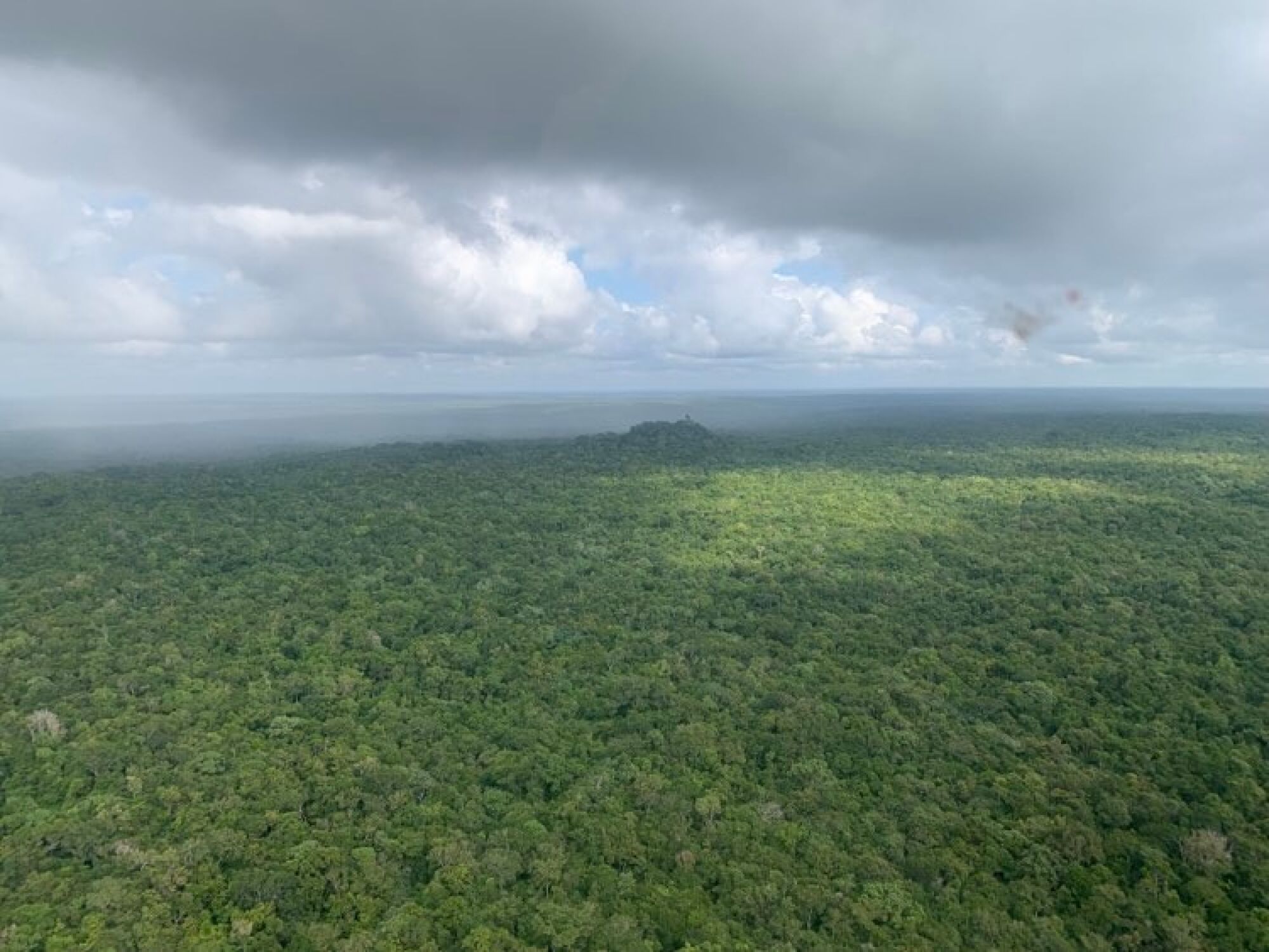
Aerial view of the archaeological site of El Mirador in the Peten province of Guatemala.
(Alejandro Maciel)
Perils, human and nonhuman
The Maya Biosphere Reserve has endured decades of exploitation and abuse that threaten its survival. After the Amazon rainforest, the reserve is the most important ecological lung in Latin America, and its conservation could help mitigate the worst effects of climate change.
Established in 1990 by Guatemala’s National Council of Protected Areas, the reserve is home to at least 513 species of birds, 56 types of reptiles and amphibians, 16 species of fish and more than 700 species of mammals — many of them, such as the jaguar, facing extinction. Hansen’s multidisciplinary studies also have focused on geology, geomorphology and hydrology. His team from Universidad del Valle in Guatemala City has discovered 27 species of moths and butterflies found nowhere else on Earth.
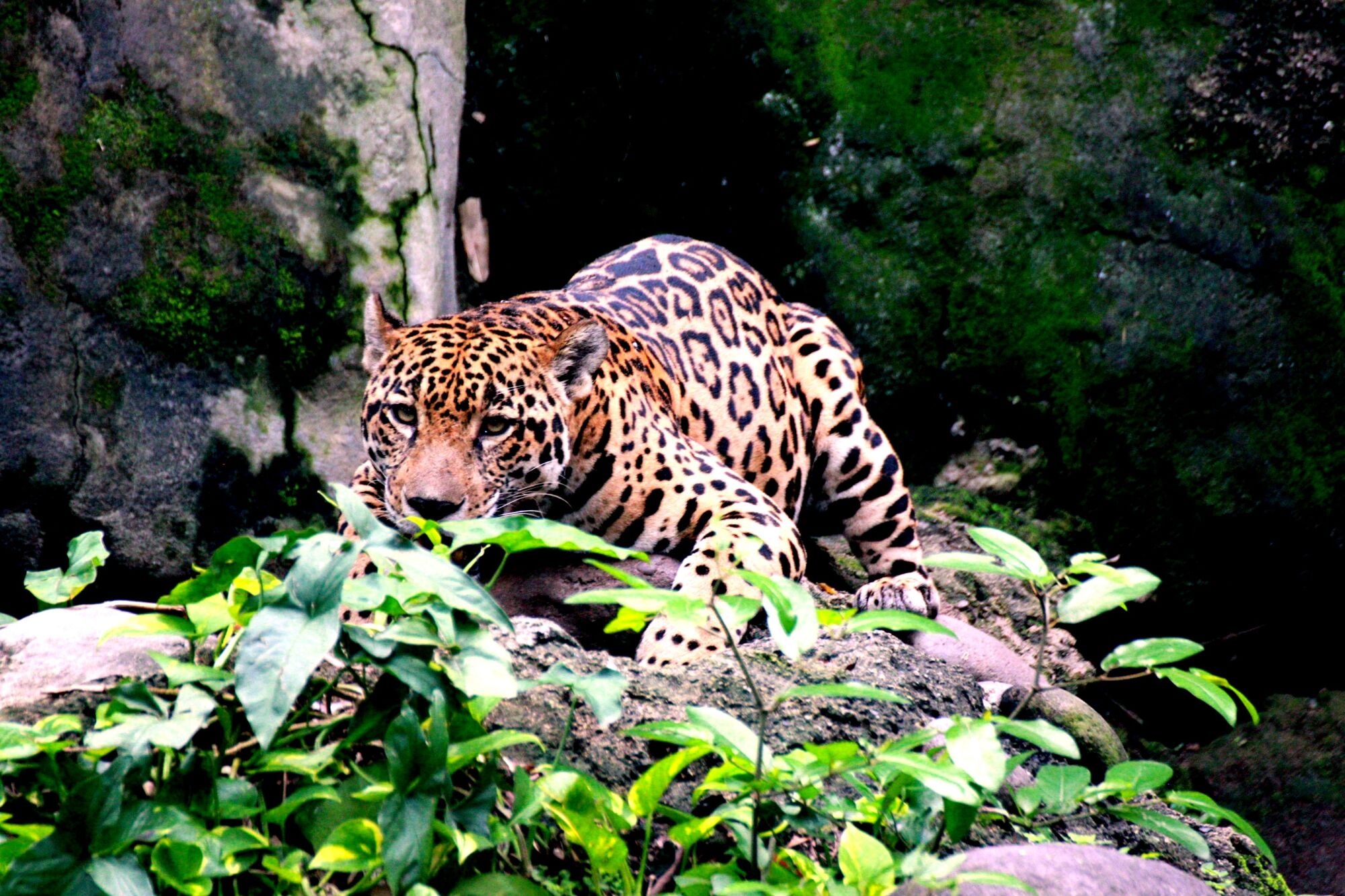
A jaguar crouches in an area that was once part of the ancient city of El Mirador. Some environmentalists fear that tourism may jeopardize jaguars and other fauna.
(Mirador Basin Project)
El Mirador consists of hundreds of structures dating from the Middle Preclassic and Late Preclassic periods (1000 BC to AD 150). Two standouts are the pyramids of El Tigre and La Danta, the latter with a height of 236 feet and a volume greater than those of the pyramids of Egypt and the Pyramid of the Sun in Teotihuacán, Mexico, Hansen said.
Danilo, the guide leading us along an intricate path, spoke to the tropical forest as he would to an old acquaintance. He told the jungle that we just wanted to hear its silence — its purest essence.
“That is the voice of the forest. It’s the way in which the forest speaks,” Danilo said.
Suddenly, a jaguar’s roar broke the spell, giving us shivers.
“That is the voice of the forest. It’s the way in which the forest speaks.”
— Danilo, a forest guide
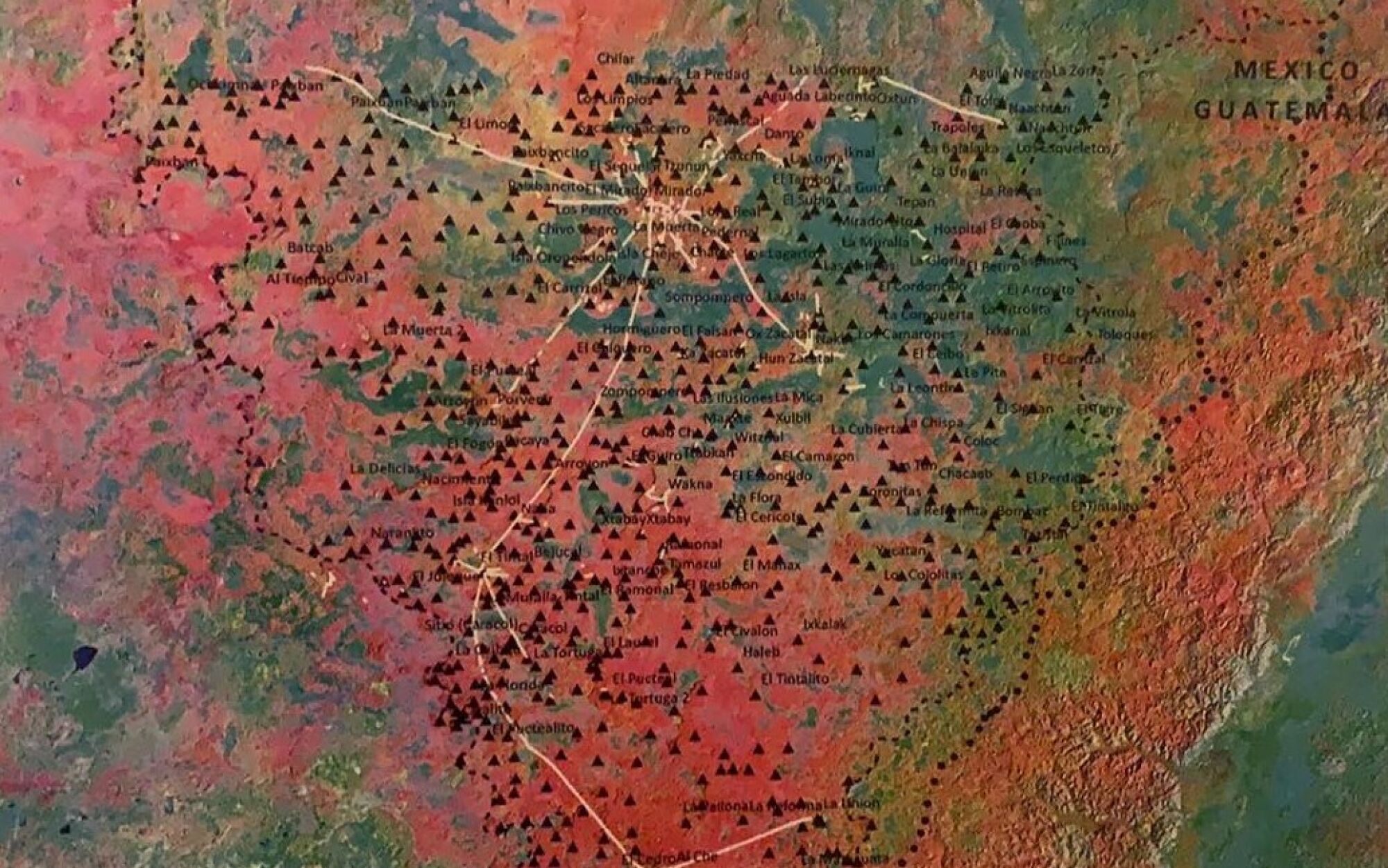
In this image, each triangle represents an archaeological site. The white lines are remnants of ancient Maya roads.
(El Mirador Project)
To reach this spot, we had boarded a helicopter in the city of Las Flores, at the jungle’s edge. From 1,000 feet, we suddenly saw huge clearings, often a sign of families that have illegally built homes in the jungle.
Organized crime has been slowly entering this territory, which is poorly regulated by the Guatemalan authorities. Some clearings are ranches operated by drug cartels for money laundering, we later were told by one community member who asked for anonymity for fear of reprisals.
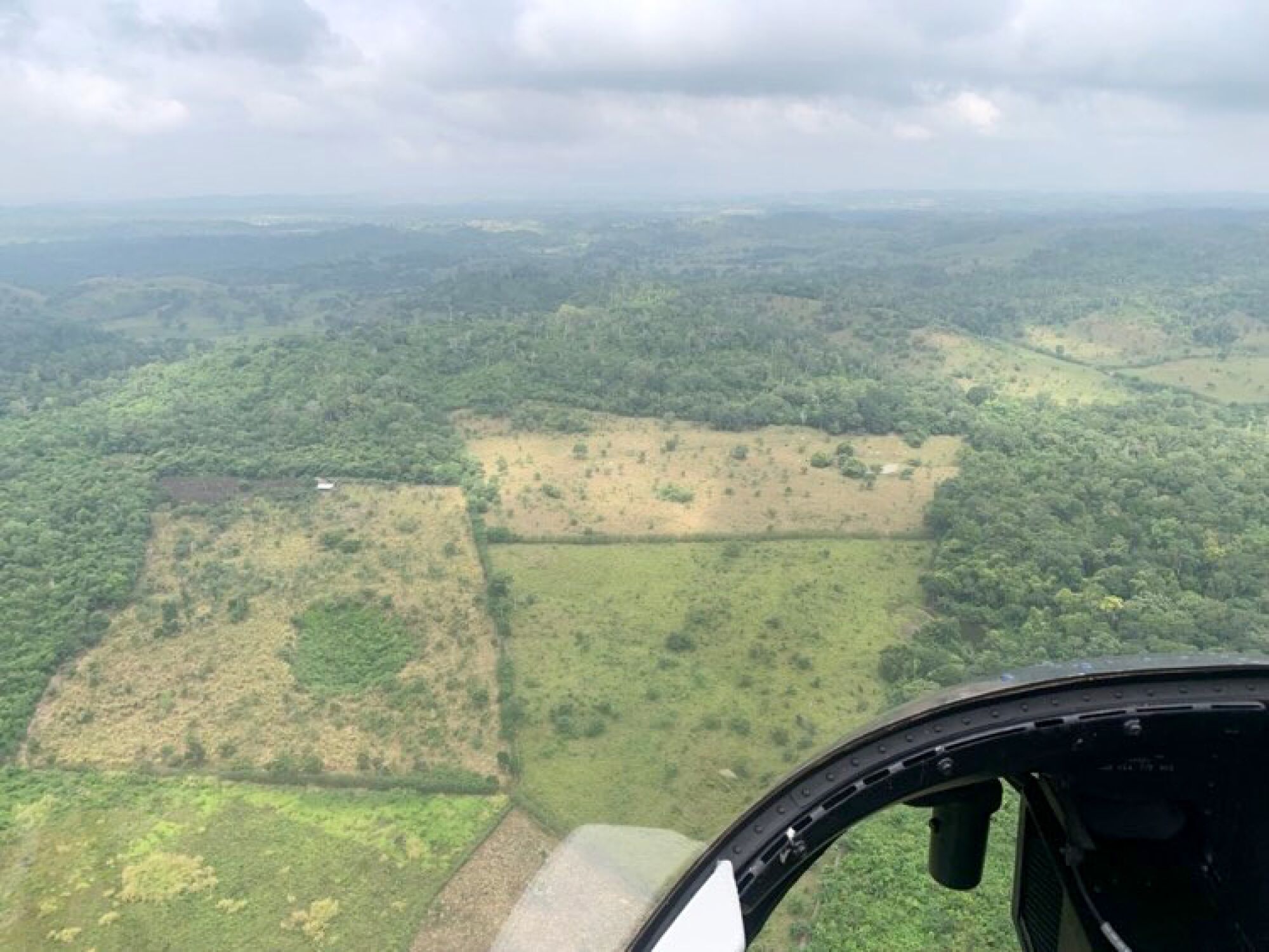
An aerial view of the deforestation on the outskirts of the Mirador Basin. Illegal logging and “narco-cattle” ranching are some of the primary threats to the extraordinary archaeological sites in the area.
(Alejandro Maciel)
According to sources at the Mexican government’s National Intelligence Center, in the Guatemalan province of Petén, bordering Mexico, there are at least seven groups of illegal loggers furtively extracting wood that they market in southeastern Mexico.
About 30 minutes into our flight we spotted what appeared to be hills breaking above the plain. They were pyramids.
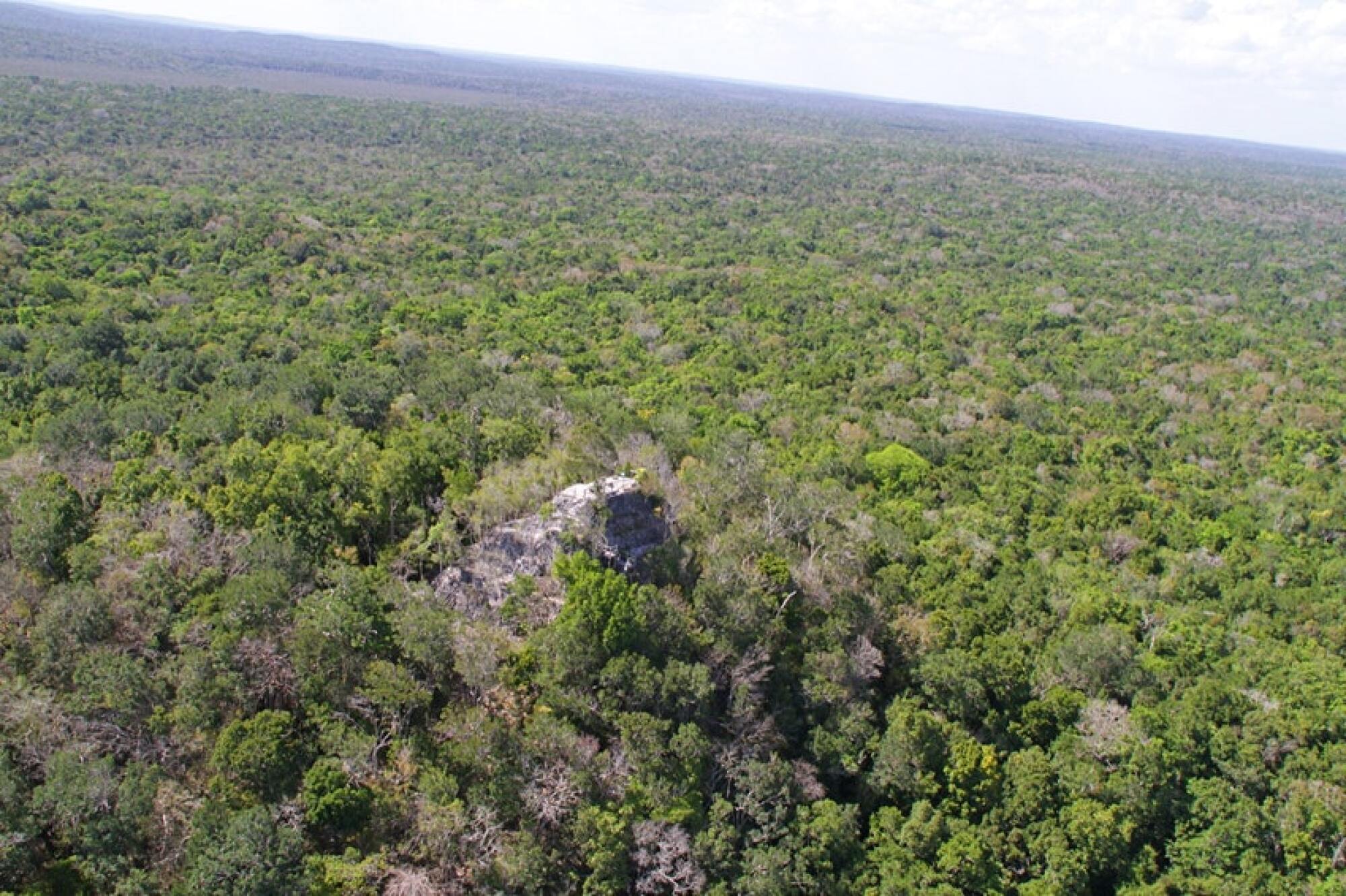
The top of La Danta, the highest pyramid in the Mirador Basin, is almost hidden by tropical vegetation.
(Alejandro Maciel)
As we flew over La Danta pyramid, we observed straight lines branching out in several directions and extending miles through the jungle. They are ancient roads, once used for moving exotic goods through sophisticated Maya trade networks.
“We have discovered some sections of tracks up to 28 kilometers [about 17 miles] long. They are the highways of that time,” said archaeologist Enrique Hernández.
The pilot’s swift, skillful descent brought us straight into El Mirador. Spider monkeys welcomed us by tossing branches and spitting from the treetops.
Estuardo Labbé, director of the Guatemalan branch of Hansen’s Foundation for Anthropological Research and Environmental Studies, offered some useful tips about navigating the wilderness confronting us.
“You must be very careful with the flies, which are almost invisible; with the ticks that stick all over your body; and with the vipers, especially with the coral, the rattlesnake and especially with the barba amarilla [yellow beard],” he said. “This is very dangerous because it is completely hidden in the ground and sometimes hangs from trees, so the bite can be on the neck or face.”
Tourists who want to visit this area must first travel to the communities of Carmelita or Uaxactun, about 40 miles to the south. There they can hire a guide, a camp cook and a pack of mules to lead them to El Mirador. On average it is 2½ days of an exhausting walk.
“It’s not easy to get here,” Hansen said as he helped unload food from our helicopter.
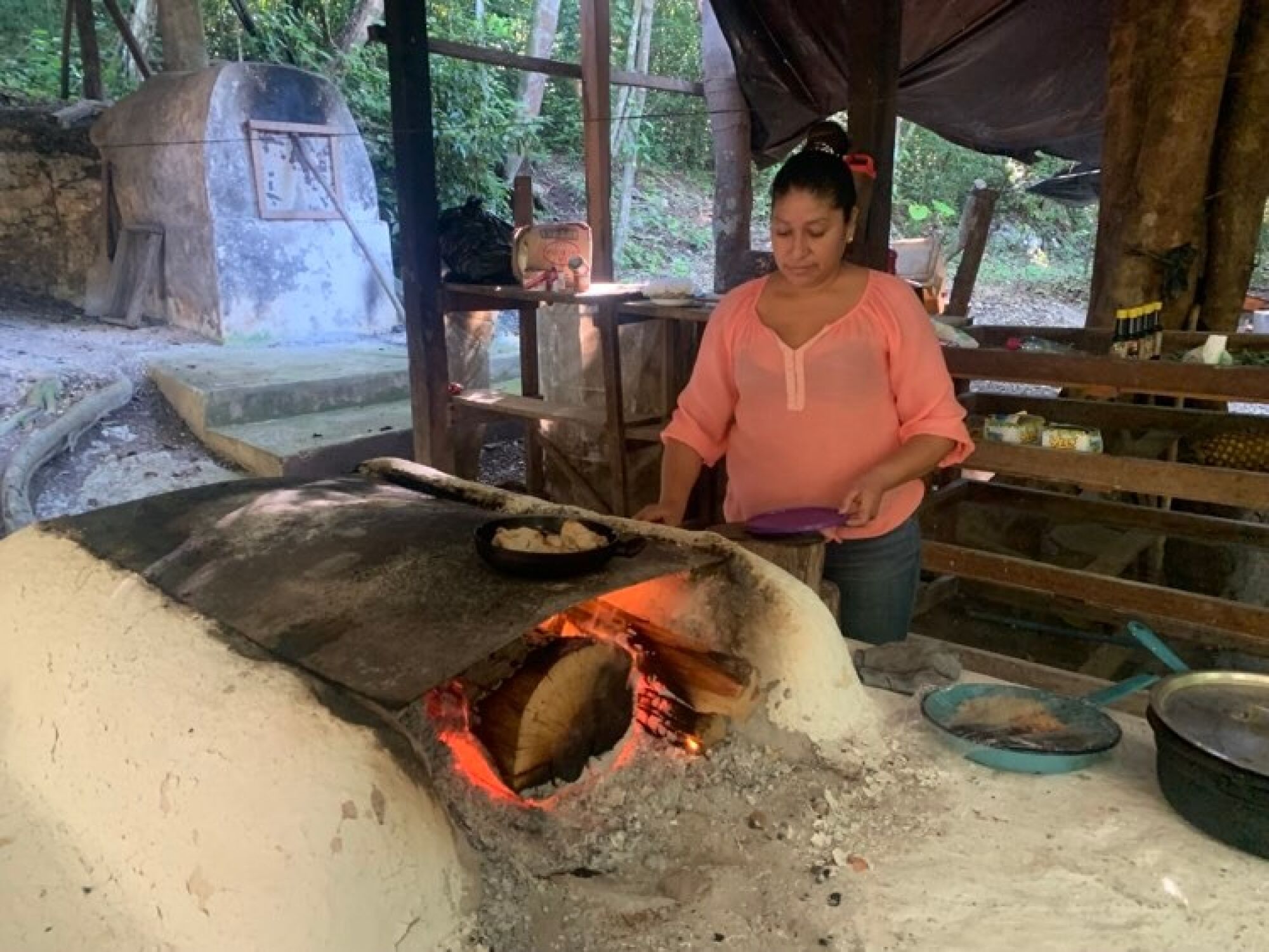
Tourists must contract with companies whose employees are used to cooking in a jungle setting.
(Alejandro Maciel)
Visitors to El Mirador often recognize Hansen. They surround him as if he were a movie star, and ask questions that he answers eagerly and expansively. His Indiana Jones mystique helps raise the project’s international profile and secure financial support.
Hansen and his family have been coming here for decades. “My children have grown up learning about the jungle and the rich cultural heritage here,” he said.
In 1983, while traveling in a small plane from Las Flores, Hansen, his wife, Jody, and his daughter Micalena crashed in the middle of the jungle. Everyone got out alive, but the episode brought home that, while the region’s perils are constantly close by, help is very far away.
Pedro Córdova, who for 28 years was director of the Institute of Anthropology and History in Petén, knows this well.
“There are many dangers,” he said. “We know of the presence of drug traffickers who unload drugs on the roads and tracks to the west, but we can’t do anything.”
The Mirador Basin Project has maintained guards and a security system since 1992 to protect the area against illegal loggers, but it is an insufficient deterrent.
“They come in armed, the same as with drug traffickers,” Córdova said.
A Maya cautionary tale
El Mirador has been known since 1882, when the Mexico-Guatemala border was surveyed. But its archaeological riches weren’t widely broadcast until 1967, even though aerial photographs had been published in 1930 and a Carnegie Foundation expedition managed to locate a portion of the city in 1932.
Based on a map of the site published in 1967 by Harvard University archaeologist Ian Graham, a rescue plan called the Mirador Archaeological Project was launched in the 1970s.
Researchers from the University of Pennsylvania and Vanderbilt University were among those who took part. As a young student, Hansen was in charge of the Tigre Complex in the western sector of the site, and discovered Preclassic ceramics on the floors of the main structures. Based on these discoveries, it was possible to determine the age of the site.
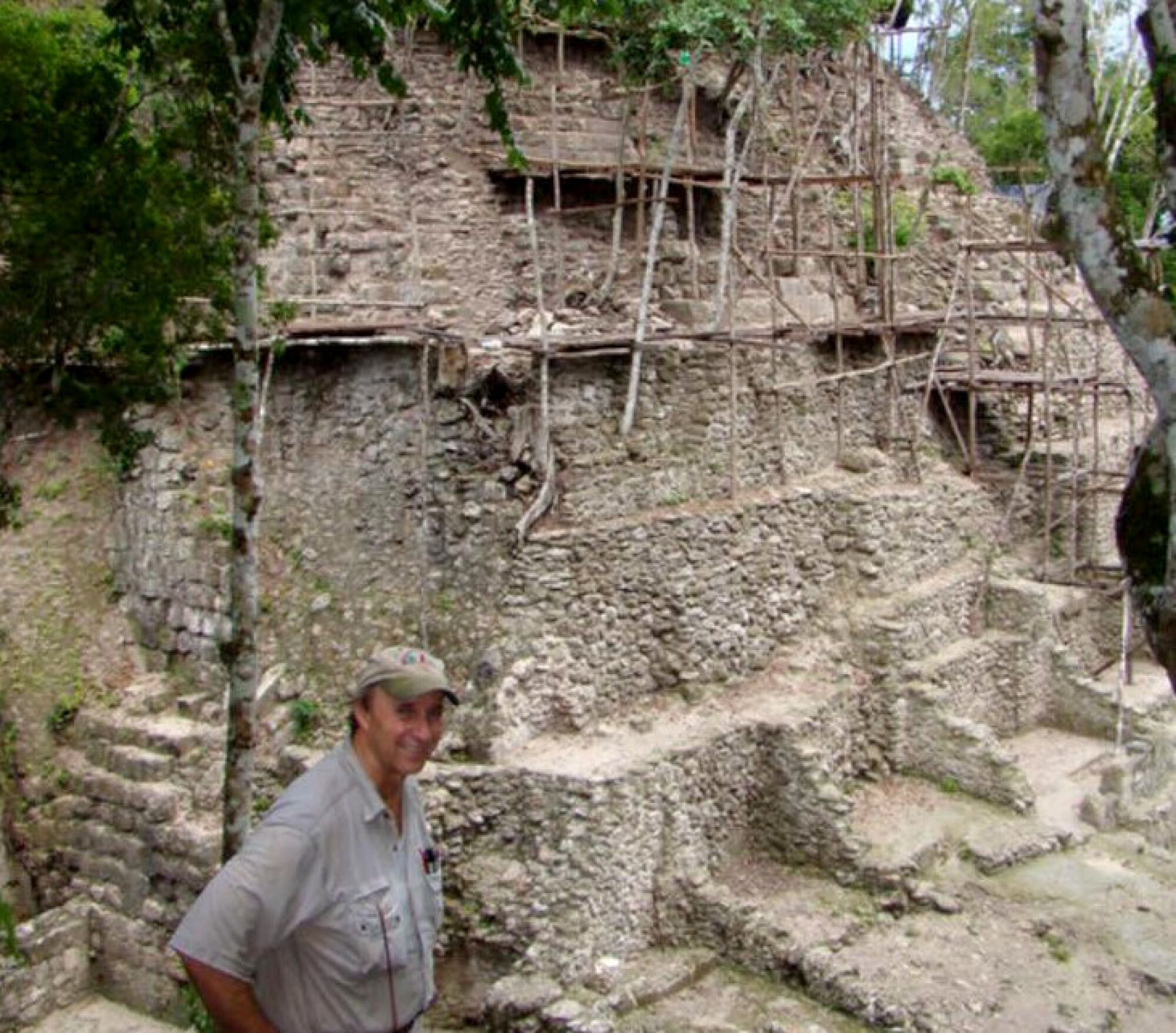
Richard Hansen while observing an excavation on the summit of La Danta pyramid in El Mirador in 2009.
(Mirador Basin Project)
Academics have scientifically established that the archaeological sites of the Mirador-Calakmul Karst Basin are between 1,000 and 2,000 years older than other sites belonging to the same Maya civilization, such as Chichen Itza and Tikal.
Rich and powerful, the Maya thrived for centuries by depleting the jungle’s seemingly endless assets: wood for construction, nutrient-rich swamp mud for their agricultural terraces, and so on. But with power came luxury, and with luxury came excess.
Social status manifested itself by using lime plaster as a dazzling adornment on houses, public plazas and massive temples. Burning vast amounts of wood to convert limestone into quicklime ravaged the forests, which led to soil erosion and water contamination.
Scientists speculate that, gradually but relentlessly, the microclimate around El Mirador began to change, exacerbating drought and other problems that may have led to famine. It is thought that El Mirador civilization caved in between AD 100 and 200. Plundering the planet has consequences.
“They did it because they could, because they had the power, because they stopped thinking about the future and the fatal consequences of environmental abuse,” Hansen said. “I find it curious that much of the same mentality and attitudes continue to the present day.”
Good works, or Yankee imperialism?
In Carmelita, more than half of the heads of the village’s 106 families are members of the Cooperativa Integral de Comercialización Carmelita, which since 1998 has had a concession from the Guatemalan government to exploit timber and non-timber products from the Maya Biosphere Reserve.
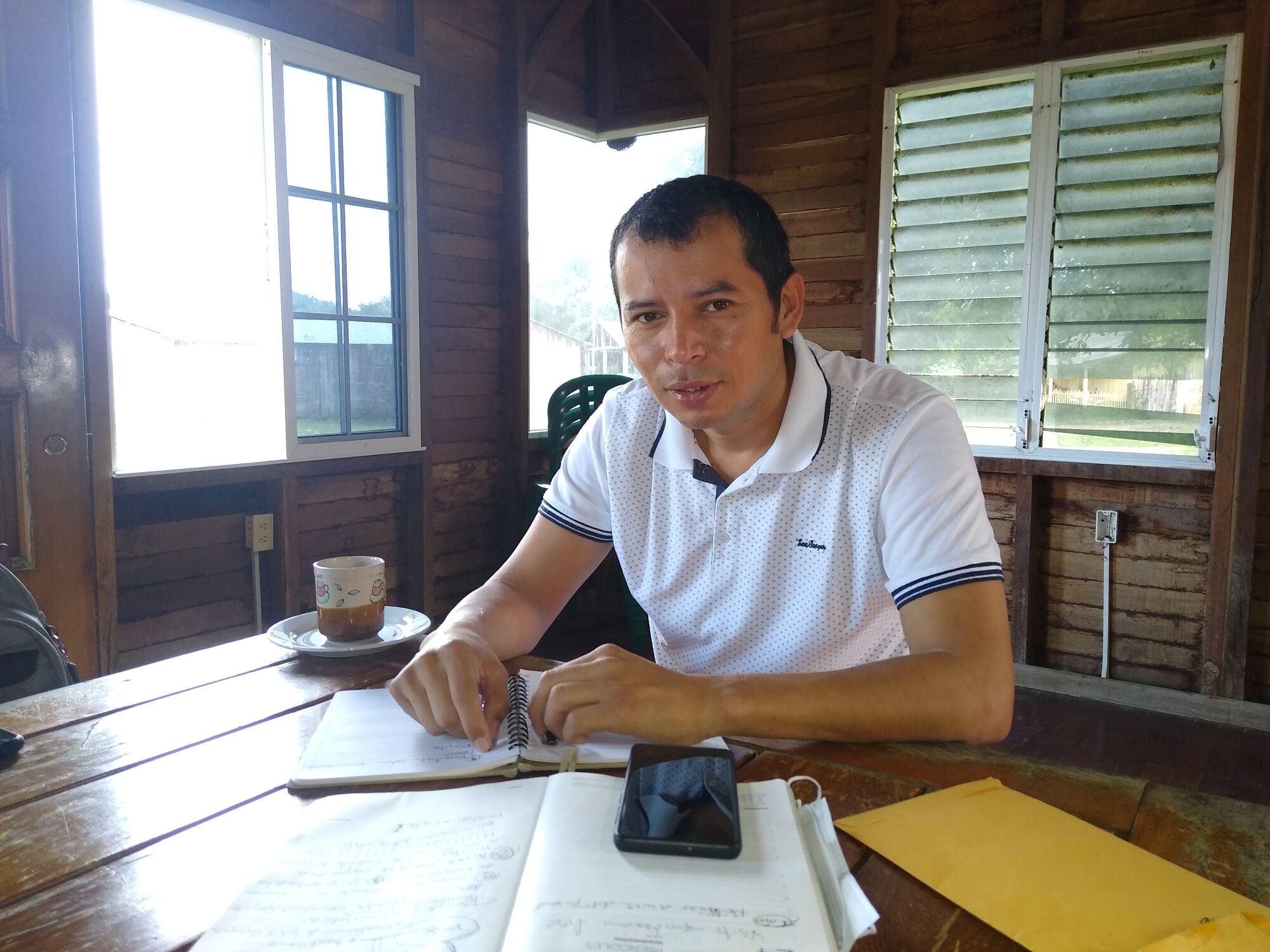
Carlos Alberto Crasborn Ojeda, director of the logging concession in Carmelita, maintains that Richard Hansen and his archaeological team want to create a private tourist development in the region.
(J. Jesús Lemus)
In Carmelita, poverty seeps through the cracks of the houses, which all seem arranged at random, alongside unruly clusters of mahogany, cedar and ceiba trees. The only structures with a fixed telephone line, wireless internet, even electricity, are the offices of the cooperative. At night the only light comes from passing motorcycles. Neighbors patrol the streets in self-defense groups.
In Carmelita, explained cooperative leader Carlos Alberto Crasborn Ojeda, most families live off what the jungle gives them. “The forest allows us to live with dignity,” he said. “And so we want to continue living, in full harmony with the forest.”
He’s suspicious of proposals to bring more archaeological tourism to the area, including rumors of a scheme to construct a Disneyland-style mini train line serving what he fears would be a privately operated theme park.
Hansen and his colleagues insist that they don’t want to be involved in any specific plans to develop the area, and have limited themselves to offering general recommendations to the government. Encouraging eco-friendly tourism, and opening a train line, Hansen said, “would be preferable to building highways or airports that could usher more organized crime into the area.”
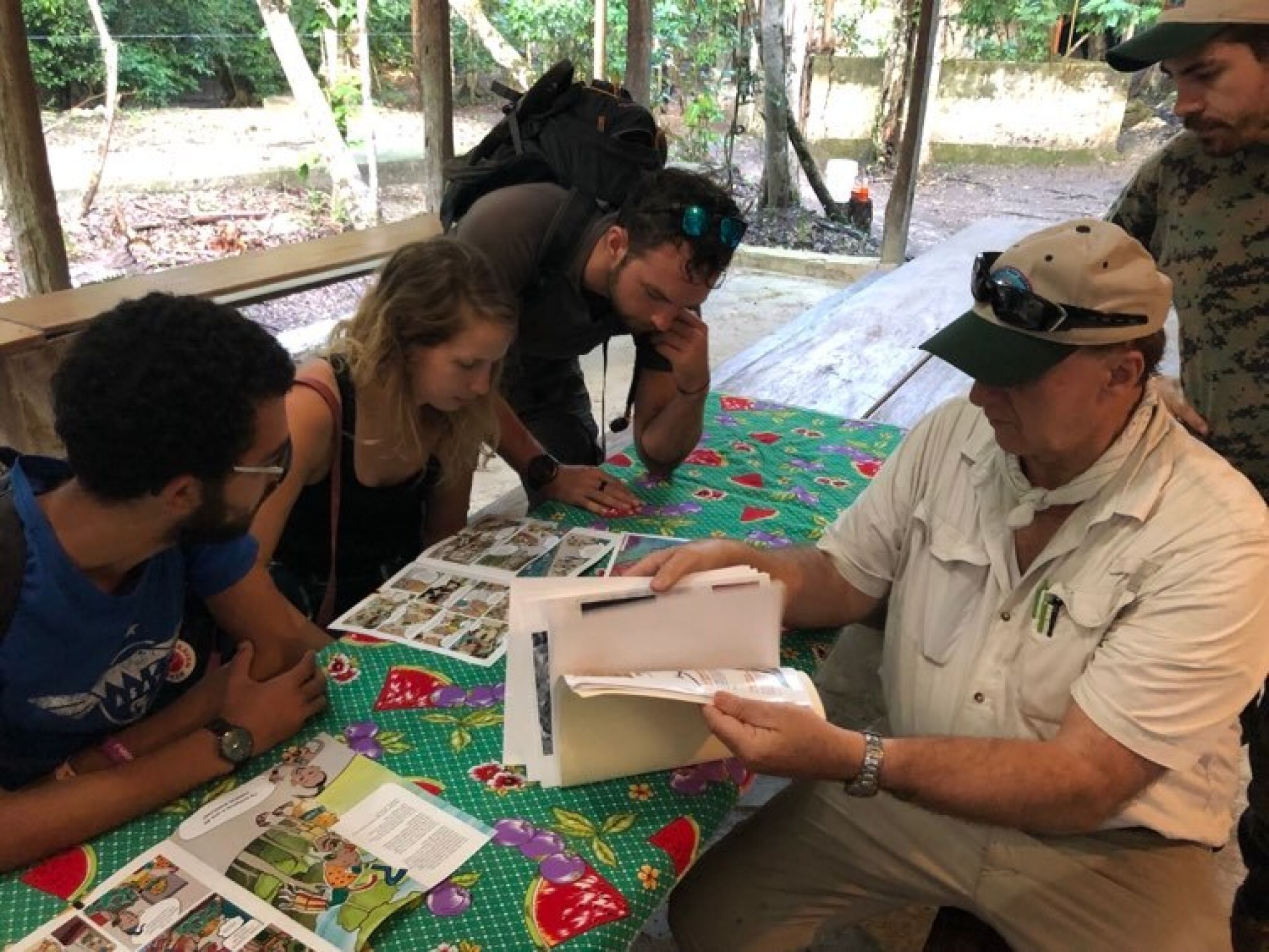
A group of tourists listens to Richard Hansen at the camp in El Mirador. The trek there by foot takes 2½ days.
(Alejandro Maciel)
The U.S. Senate has weighed in on the importance of El Mirador, through legislation known as the Mirador-Calakmul Basin Maya Security and Conservation Partnership Act of 2019 that would help funnel $72 million over six years toward the project for research, conservation and safety operations.
But some critics have denounced this U.S. proposal as covert Yankee imperialism, and Hansen as its agent.
Among his main detractors is the Italian Guatemalan archaeologist Francisco Estrada-Belli, who wrote on Twitter in 2019 that “Richard Hansen is seeking $100 million from the United States government to be able to control for always most of the Maya Biosphere Reserve in Guatemala. He has already done it for 40 years and it has alienated the whole world. It’s enough. #stopthisBS.”
Hansen finds it bewildering that a project that would increase economic prosperity and protect cultural treasures faces such opposition.
“All the world is clamoring about climate change, and here we have a real, viable solution for that problem, and there is major opposition against it,” he said.
“The Maya culture and the jungle must be a heritage of all Guatemalans and not of a small group,” Hansen continued. “We only make recommendations to save this area from very real threats, and it is ultimately a decision of the government and the Guatemalan people to save one of the greatest cultural and natural legacies ever known. We can only hope they grasp the vision of the significance of this for future generations.”
Whatever the fate of El Mirador, and the surrounding jungle, it will be in the hands of its human inhabitants — just as it was for the ancient Maya.
